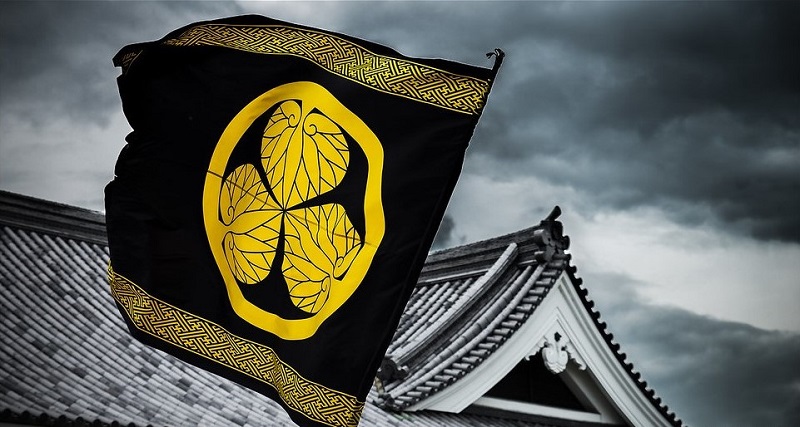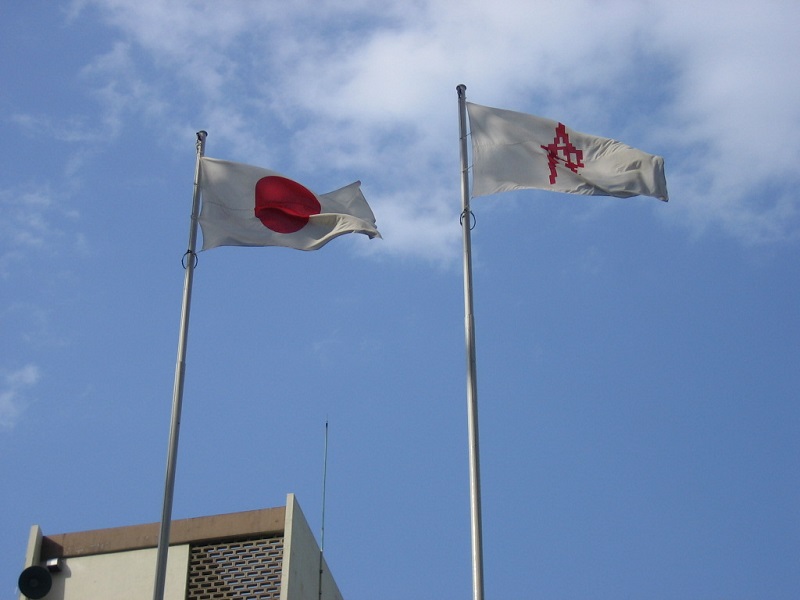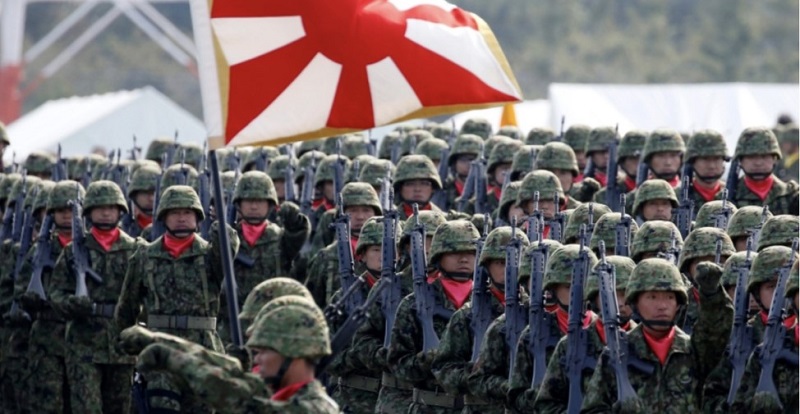The flag of Japan is one of the most elegant and minimalistic in the world. With a plain red sun on a white base, it’s worldwide recognizable. But did you know that national flags of Japan went a long way before they finally set for the current one in 1999?
Brief History

The flag of the Tokugawa Shogunate, which was the last feudal military government in Japan, consisted of a simple white field with a black line running through the centre.
In the year 1868, in the northern region of Japan near Hokkaido, there was a short-lived Republic of Ezo. The flag of this republic was comprised of a dark blue field with a prominent chrysanthemum and a seven-pointed red star positioned at the centre.
During the period between 1869 and 1875, the Ryuku Kingdom enjoyed independence from Japan and had its own distinct flag. This flag showcased the crest of the Ryukyu Sho Dynasty, placed in the centre of a white field, with black-red-black bands located in the lower portion.
The flag of the Empire of Japan, which was adopted as a civil flag in 1868, is officially known as Nisshōki and unofficially referred to as Hinomaru. It features a plain white field with a red disc positioned at the centre. Since 1999, it has also served as the national flag of Japan.
At First People Didn’t Like It
When it was first introduced, citizens needed to greet the emperor with the flag. This led to some protests as some Japanese people resented its presence. However, over time, it gained acceptance among the people. Before World War II, homes were required to display the Hinomaru on national holidays.
After the war, the display of it became mainly limited to government buildings like city halls, both at the national and local levels. Private homes and commercial buildings rarely displayed the flag, although there were some companies and individuals who advocated for its display on holidays.
While the government of Japan encourages citizens and residents to fly it during national holidays, it is not legally required to do so. A notable example of the flag being displayed is by the Kyushu Railway Company. Since the emperor’s 80th birthday on December 23, 2002, they have displayed the Hinomaru at 330 stations.
A Few Interesting Facts About Japanese Flags

It’s Displayed All Day
The Japanese Flag is proudly displayed throughout the day by the protocols set by the government of Japan. It’s allowed to be flown from sunrise until sunset, while schools and businesses have the freedom to raise and lower it during their opening and closing hours.
In situations where the national flags of Japan are flown alongside another country’s flag, the Japanese Flag is given the position of honour, with the guest country’s flag flying to its right. Both flags must be of equal size and height, symbolizing mutual respect. If multiple foreign flags are displayed, the Japanese Flag is arranged in alphabetical order as prescribed by the United Nations. When the Japanese Flag becomes unsuitable for use, it is traditionally burned in private, as a respectful way of retiring it.
The Biggest Japanese Flag
The largest Japanese flag at the Izumo shrine in Shimane prefecture. This magnificent flag spans an impressive 9×13.6 meters, flying 47 meters high and weighing 49 kilograms. Although it’s no longer officially used by the government due to its aggressive and imperialistic symbolism, it remains a prominent symbol on commercial packaging and within the Japanese defence force. However, it’s important to note that this flag can be seen as offensive to countries with anti-Japanese sentiments, particularly China and South Korea.
Two Styles to Express Mourning
This flag is used in two different styles to express mourning. One way is by displaying it at half-staff, a practice common in many countries. Additionally, the Ministry of Foreign Affairs office raises the Flag at half-staff during the funeral of a foreign nation’s head of state. The other method involves wrapping the spherical finial with black cloth and placing a black ribbon, known as a mourning flag, above the flag. This tradition dates back to the death of Emperor Meiji on July 30, 1912, when the cabinet issued an ordinance stating that the National Flag should be raised in mourning. The cabinet holds the authority to announce the half-staffing of the National Flag.
Specific Manufacturing Guidelines

In 1973, the Japan Defense Agency (now the Ministry of Defense) specification changed the colours of the flag to 5R 4/12 for red and N9 for white in the Munsell colour chart. On March 21, 2008, the document was updated to align the flag’s construction with current legislation and to update the Munsell colours.
According to the document, acrylic fibre and nylon are listed as suitable materials for military flags. For acrylic, the red colour is 5.7 R, 3.7/15.5 and white is N9.4. Nylon, on the other hand, has 62R 4/15.2 for red and N9.2 for white. The colour codes for Hinomaru and the Official Development Assistance (ODA) are listed as DIC 156 and CMYK 0-100-90-0 in a document issued by ODA.
